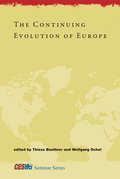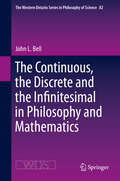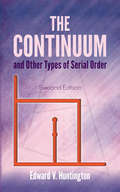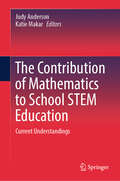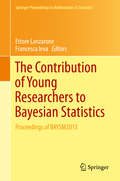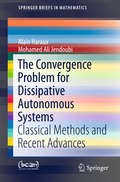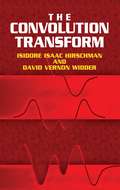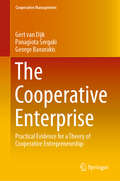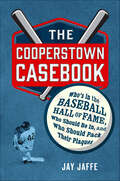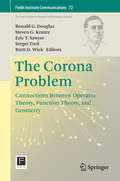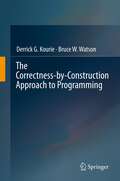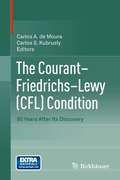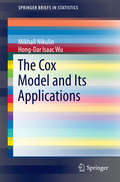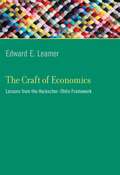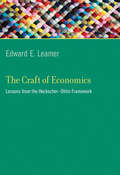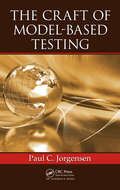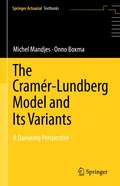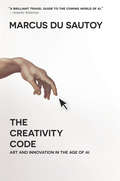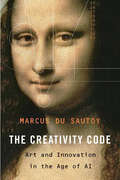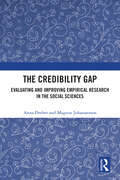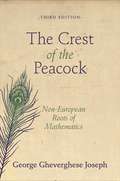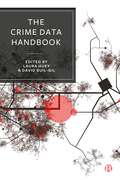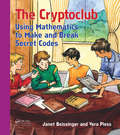- Table View
- List View
The Continuing Evolution of Europe (CESifo Seminar Series)
by Thiess Buettner Wolfgang OchelEconomists address key challenges facing the EU, including financial instability, welfare state reform, inadequate institutional framework, and global economic integration.The European Union began with efforts in the Cold War era to foster economic integration among a few Western European countries. Today's EU constitutes an upper tier of government that affects almost every level of policymaking in each of its twenty-seven member states. The recent financial and economic crises have tested this still-evolving institutional framework, and this book surveys key economic challenges faced by the EU.Prominent European economists examine such topics as the stability of the financial markets and possible policy options to reduce future vulnerability to crises, including Glass-Steagull-style narrow banking; the effect of emerging economies such as China and India on Europe's economic position; the protection of national interests in industrial policy; reforming and preserving the welfare state in the face of unemployment, population aging, and worker mobility within the EU; and improving the EU's institutional framework by reassigning responsibilities among supranational, national, and local governments.Among the conclusions that emerge from these analyses are the necessity for banking regulation as well as budgetary discipline; the need to consider global as well as European integration; and the idea that an environment that fosters internal competition will increase Europe's competitiveness internationally.
The Continuous, the Discrete and the Infinitesimal in Philosophy and Mathematics (The Western Ontario Series in Philosophy of Science #82)
by John L. BellThis book explores and articulates the concepts of the continuous and the infinitesimal from two points of view: the philosophical and the mathematical. The first section covers the history of these ideas in philosophy. Chapter one, entitled ‘The continuous and the discrete in Ancient Greece, the Orient and the European Middle Ages,’ reviews the work of Plato, Aristotle, Epicurus, and other Ancient Greeks; the elements of early Chinese, Indian and Islamic thought; and early Europeans including Henry of Harclay, Nicholas of Autrecourt, Duns Scotus, William of Ockham, Thomas Bradwardine and Nicolas Oreme. The second chapter of the book covers European thinkers of the sixteenth and seventeenth centuries: Galileo, Newton, Leibniz, Descartes, Arnauld, Fermat, and more. Chapter three, 'The age of continuity,’ discusses eighteenth century mathematicians including Euler and Carnot, and philosophers, among them Hume, Kant and Hegel.Examining the nineteenth and early twentieth centuries, the fourth chapter describes the reduction of the continuous to the discrete, citing the contributions of Bolzano, Cauchy and Reimann. Part one of the book concludes with a chapter on divergent conceptions of the continuum, with the work of nineteenth and early twentieth century philosophers and mathematicians, including Veronese, Poincaré, Brouwer, and Weyl.Part two of this book covers contemporary mathematics, discussing topology and manifolds, categories, and functors, Grothendieck topologies, sheaves, and elementary topoi. Among the theories presented in detail are non-standard analysis, constructive and intuitionist analysis, and smooth infinitesimal analysis/synthetic differential geometry.No other book so thoroughly covers the history and development of the concepts of the continuous and the infinitesimal.
The Continuum: and Other Types of Serial Order (Dover Books on Mathematics)
by Edward V. HuntingtonThis classic of mathematics presents the best systematic elementary account of the modern theory of the continuum as a type of serial order. Based on the Dedekind-Cantor ordinal theory, this text requires no knowledge of higher mathematics. Contents include a historical introduction and chapters on classes in general; simply ordered classes, or series; discrete series, especially the type of the natural numbers; dense series, especially the type of the rational numbers; continuous series, especially the type of the real numbers; continuous series of more than one dimension, with a note on multiply ordered classes; and well ordered series, with an introduction to Cantor's transfinite numbers. 1917 edition. 119 footnotes, mostly bibliographical.
The Contribution of Mathematics to School STEM Education: Current Understandings
by Katie Makar Judy AndersonThis book presents contemporary STEM education research conducted by mathematics education researchers and their collaborators which highlights the important and pivotal role of mathematics in school STEM education. It showcases evidence of the types of integrated curriculum approaches to STEM education which highlight mathematics as a key component and where mathematical concepts can be learnt through integrated tasks. These examples challenge the idea that mathematics is just an application or ‘servant’ to the other STEM subjects and highlight the contribution that mathematics can make to the understanding and practices of the other STEM subjects. This book fills a void in the current research literature on the role of mathematics in STEM education, provides evidence of the possibilities for designing integrated STEM curriculum and highlights current understandings of the role of mathematics in school STEM education. For researchers, it identifies and elaborates gaps to encourage further exploration in this field.
The Contribution of Young Researchers to Bayesian Statistics
by Ettore Lanzarone Francesca IevaThe first Bayesian Young Statisticians Meeting, BAYSM 2013, has provided a unique opportunity for young researchers, M. S. students, Ph. D. students, and post-docs dealing with Bayesian statistics to connect with the Bayesian community at large, exchange ideas, and network with scholars working in their field. The Workshop, which took place June 5th and 6th 2013 at CNR-IMATI, Milan, has promoted further research in all the fields where Bayesian statistics may be employed under the guidance of renowned plenary lecturers and senior discussants. A selection of the contributions to the meeting and the summary of one of the plenary lectures compose this volume.
The Convergence Problem for Dissipative Autonomous Systems
by Alain Haraux Mohamed Ali JendoubiThe book investigates classical and more recent methods of study for the asymptotic behavior of dissipative continuous dynamical systems with applications to ordinary and partial differential equations, the main question being convergence (or not) of the solutions to an equilibrium. After reviewing the basic concepts of topological dynamics and the definition of gradient-like systems on a metric space, the authors present a comprehensive exposition of stability theory relying on the so-called linearization method. For the convergence problem itself, when the set of equilibria is infinite, the only general results that do not require very special features of the non-linearities are presently consequences of a gradient inequality discovered by S. Lojasiewicz. The application of this inequality jointly with the so-called Liapunov-Schmidt reduction requires a rigorous exposition of Semi-Fredholm operator theory and the theory of real analytic maps on infinite dimensional Banach spaces, which cannot be found anywhere in a readily applicable form. The applications covered in this short text are the simplest, but more complicated cases are mentioned in the final chapter, together with references to the corresponding specialized papers.
The Convolution Transform (Dover Books on Mathematics)
by David V. Widder Isidore Isaac HirschmanIn studies of general operators of the same nature, general convolution transforms are immediately encountered as the objects of inversion. The relation between differential operators and integral transforms is the basic theme of this work, which is geared toward upper-level undergraduates and graduate students. It may be read easily by anyone with a working knowledge of real and complex variable theory. Topics include the finite and non-finite kernels, variation diminishing transforms, asymptotic behavior of kernels, real inversion theory, representation theory, the Weierstrass transform, and complex inversion theory.
The Cooperative Enterprise: Practical Evidence for a Theory of Cooperative Entrepreneurship (Cooperative Management)
by George Baourakis Gert van Dijk Panagiota SergakiThis book presents a study of cooperatives as a two-layer entrepreneurial model, and analyzes cooperative enterprises. Above all, it explores how inducements (from the firm) and contributions (from its members, in their respective roles) are aligned, and seeks to answer the question of what this means for managing each cooperative as a firm as well as a group. The book is divided into three parts, the first of which begins with an analysis of specific aspects of cooperative enterprises, with a focus on the added value of cooperation, the weighing of interests, and a behavioral perspective on the imminent communities and their goals. In a structured approach, the book examines the various facets of relationships in cooperatives on a transactional, financial and control level. Further, a case study on the Dutch cooperative Rabobank illustrates what happens when members fail. In turn, part two concentrates on integrating the lessons learned with the existing economic literature on cooperatives, so as to contribute to a theory of cooperative management. Finally, the book links the theoretical approach to practice: in the third part, it reports on the outcomes of using a computerized simulation game to show members of cooperatives how to manage their business and the cooperative business at the same time, enabling them to understand and actively practice two-level entrepreneurship.
The Cooperstown Casebook: Who's in the Baseball Hall of Fame, Who Should Be In, and Who Should Pack Their Plaques
by Jay JaffeA revolutionary method for electing players to the Baseball Hall of Fame from Sports Illustrated writer Jay Jaffe, using his popular and proprietary “JAWS” ranking system.The National Baseball Hall of Fame and Museum, tucked away in upstate New York in a small town called Cooperstown, is far from any major media market or big league stadium. Yet no sports hall of fame’s membership is so hallowed, nor its qualifications so debated, nor its voting process so dissected. Since its founding in 1936, the Hall of Fame’s standards for election have been nebulous, and its selection processes arcane, resulting in confusion among voters, not to mention mistakes in who has been recognized and who has been bypassed. Numerous so-called “greats” have been inducted despite having not been so great, while popular but controversial players such as all-time home run leader Barry Bonds and all-time hits leader Pete Rose are on the outside looking in. Now, in The Cooperstown Casebook, Jay Jaffe shows us how to use his revolutionary ranking system to ensure the right players are recognized. The foundation of Jaffe’s approach is his JAWS system, an acronym for the Jaffe WAR Score, which he developed over a decade ago. Through JAWS, each candidate can be objectively compared on the basis of career and peak value to the players at his position who are already in the Hall of Fame. Because of its utility, JAWS has gained an increasing amount of exposure in recent years. Through his analysis, Jaffe shows why the Hall of Fame still matters and how it can remain relevant in the 21st century.
The Corona Problem
by Steven G. Krantz Ronald G. Douglas Eric T. Sawyer Sergei Treil Brett D. WickThe purpose of the corona workshop was to consider the corona problem in both one and several complex variables, both in the context of function theory and harmonic analysis as well as the context of operator theory and functional analysis. It was held in June 2012 at the Fields Institute in Toronto, and attended by about fifty mathematicians. This volume validates and commemorates the workshop, and records some of the ideas that were developed within. The corona problem dates back to 1941. It has exerted a powerful influence over mathematical analysis for nearly 75 years. There is material to help bring people up to speed in the latest ideas of the subject, as well as historical material to provide background. Particularly noteworthy is a history of the corona problem, authored by the five organizers, that provides a unique glimpse at how the problem and its many different solutions have developed. There has never been a meeting of this kind, and there has never been a volume of this kind. Mathematicians--both veterans and newcomers--will benefit from reading this book. This volume makes a unique contribution to the analysis literature and will be a valuable part of the canon for many years to come.
The Correctness-by-Construction Approach to Programming
by Bruce W. Watson Derrick G. KourieThe focus of this book is on bridging the gap between two extreme methods for developing software. On the one hand, there are texts and approaches that are so formal that they scare off all but the most dedicated theoretical computer scientists. On the other, there are some who believe that any measure of formality is a waste of time, resulting in software that is developed by following gut feelings and intuitions. Kourie and Watson advocate an approach known as "correctness-by-construction," a technique to derive algorithms that relies on formal theory, but that requires such theory to be deployed in a very systematic and pragmatic way. First they provide the key theoretical background (like first-order predicate logic or refinement laws) that is needed to understand and apply the method. They then detail a series of graded examples ranging from binary search to lattice cover graph construction and finite automata minimization in order to show how it can be applied to increasingly complex algorithmic problems. The principal purpose of this book is to change the way software developers approach their task at programming-in-the-small level, with a view to improving code quality. Thus it coheres with both the IEEE's Guide to the Software Engineering Body of Knowledge (SWEBOK) recommendations, which identifies themes covered in this book as part of the software engineer's arsenal of tools and methods, and with the goals of the Software Engineering Method and Theory (SEMAT) initiative, which aims to "refound software engineering based on a solid theory."
The Courant–Friedrichs–Lewy (CFL) Condition
by Carlos A. de Moura Carlos S. KubruslyThis volume comprises a carefully selected collection of articles emerging from and pertinent to the 2010 CFL-80 conference in Rio de Janeiro, celebrating the 80th anniversary of the Courant-Friedrichs-Lewy (CFL) condition. A major result in the field of numerical analysis, the CFL condition has influenced the research of many important mathematicians over the past eight decades, and this work is meant to take stock of its most important and current applications. The Courant-Friedrichs-Lewy (CFL) Condition: 80 Years After its Discovery will be of interest to practicing mathematicians, engineers, physicists, and graduate students who work with numerical methods.
The Cox Model and Its Applications
by Mikhail Nikulin Hong-Dar Isaac WuThis book will be of interest to readers active in the fields of survival analysis, genetics, ecology, biology, demography, reliability and quality control. Since Sir David Cox's pioneering work in 1972, the proportional hazards model has become the most important model in survival analysis. The success of the Cox model stimulated further studies in semiparametric and nonparametric theories, counting process models, study designs in epidemiology, and the development of many other regression models that could offer more flexible or more suitable approaches in data analysis. Flexible semiparametric regression models are increasingly being used torelate lifetime distributions to time-dependent explanatory variables. Throughout the book, various recent statistical models are developed in close connection with specific data from experimental studies in clinical trials or from observational studies.
The Craft of Economics
by Edward E. LeamerIn this spirited and provocative book, Edward Leamer turns an examination of the Heckscher--Ohlin framework for global competition into an opportunity to consider the craft of economics: what economists do, what they should do, and what they shouldn't do. Claiming "a lifetime relationship with Heckscher--Ohlin," Leamer argues that Bertil Ohlin's original idea offered something useful though vague and not necessarily valid; the economists who later translated his ideas into mathematical theorems offered something precise and valid but not necessarily useful. He argues further that the best economists keep formal and informal thinking in balance. An Ohlinesque mostly prose style can let in faulty thinking and fuzzy communication; a mostly math style allows misplaced emphasis and opaque communication. Leamer writes that today's model- and math-driven economics needs more prose and less math. Leamer shows that the Heckscher--Ohlin framework is still useful, and that there is still much work to be done with it. But he issues a caveat about economists: "What we do is not science, it's fiction and journalism. " Economic theory, he writes, is fiction (stories, loosely connected to the facts); data analysis is journalism (facts, loosely connected to the stories). Rather then titling the two sections of his book Theory and Evidence, he calls them Economic Fiction and Econometric Journalism, explaining, "If you find that startling, that's good. I am trying to keep you awake. "
The Craft of Economics: Lessons from the Heckscher-Ohlin Framework (Ohlin Lectures)
by Edward E. LeamerA review of the Heckscher–Ohlin framework prompts a noted economist to consider the methodology of economics.In this spirited and provocative book, Edward Leamer turns an examination of the Heckscher–Ohlin framework for global competition into an opportunity to consider the craft of economics: what economists do, what they should do, and what they shouldn't do. Claiming “a lifetime relationship with Heckscher–Ohlin,” Leamer argues that Bertil Ohlin's original idea offered something useful though vague and not necessarily valid; the economists who later translated his ideas into mathematical theorems offered something precise and valid but not necessarily useful. He argues further that the best economists keep formal and informal thinking in balance. An Ohlinesque mostly prose style can let in faulty thinking and fuzzy communication; a mostly math style allows misplaced emphasis and opaque communication. Leamer writes that today's model- and math-driven economics needs more prose and less math.Leamer shows that the Heckscher–Ohlin framework is still useful, and that there is still much work to be done with it. But he issues a caveat about economists: “What we do is not science, it's fiction and journalism.” Economic theory, he writes, is fiction (stories, loosely connected to the facts); data analysis is journalism (facts, loosely connected to the stories). Rather than titling the two sections of his book Theory and Evidence, he calls them Economic Fiction and Econometric Journalism, explaining, “If you find that startling, that's good. I am trying to keep you awake.”
The Craft of Model-Based Testing
by Paul C. JorgensenIn his latest work, author Paul C Jorgensen takes his well-honed craftsman’s approach to mastering model-based testing (MBT). To be expert at MBT, a software tester has to understand it as a craft rather than an art. This means a tester should have deep knowledge of the underlying subject and be well practiced in carrying out modeling and testing techniques. Judgment is needed, as well as an understanding of MBT the tools. <P><P>The first part of the book helps testers in developing that judgment. It starts with an overview of MBT and follows with an in-depth treatment of nine different testing models with a chapter dedicated to each model. These chapters are tied together by a pair of examples: a simple insurance premium calculation and an event-driven system that describes a garage door controller. The book shows how simpler models—flowcharts, decision tables, and UML Activity charts—express the important aspects of the insurance premium problem. It also shows how transition-based models—finite state machines, Petri nets, and statecharts—are necessary for the garage door controller but are overkill for the insurance premium problem. Each chapter describes the extent to which a model can support MBT. <P><P>The second part of the book gives testers a greater understanding of MBT tools. It examines six commercial MBT products, presents the salient features of each product, and demonstrates using the product on the insurance premium and the garage door controller problems. These chapters each conclude with advice on implementing MBT in an organization. The last chapter describes six Open Source tools to round out a tester’s knowledge of MBT. In addition, the book supports the International Software Testing Qualifications Board’s (ISTQB®) MBT syllabus for certification.
The Cramér–Lundberg Model and Its Variants: A Queueing Perspective (Springer Actuarial)
by Michel Mandjes Onno BoxmaThis book offers a comprehensive examination of the Cramér–Lundberg model, which is the most extensively researched model in ruin theory. It covers the fundamental dynamics of an insurance company's surplus level in great detail, presenting a thorough analysis of the ruin probability and related measures for both the standard model and its variants.Providing a systematic and self-contained approach to evaluate the crucial quantities found in the Cramér–Lundberg model, the book makes use of connections with related queueing models when appropriate, and its emphasis on clean transform-based techniques sets it apart from other works. In addition to consolidating a wealth of existing results, the book also derives several new outcomes using the same methodology.This material is complemented by a thoughtfully chosen collection of exercises. The book's primary target audience is master's and starting PhD students in applied mathematics, operations research, and actuarial science, although it also serves as a useful methodological resource for more advanced researchers. The material is self-contained, requiring only a basic grounding in probability theory and some knowledge of transform techniques.
The Crayon Counting Book (Jerry Pallotta's Counting Books)
by Pam Muñoz Ryan Jerry PallottaCrayons aren't just for coloring anymore!This colorful rhyme teaches counting by twos–two different ways. First, use the even numbers to count up to 24. Then start over with the odd numbers. Along the way you'll learn unusual colors, like iguana and fiddlehead. Do any of them sound familiar? They should! They come from the pages of Jerry Pallotta's alphabet books.Counting has never been more fun or colorful!
The Creativity Code: Art and Innovation in the Age of AI
by Marcus Du SautoyMost books on AI focus on the future of work. But now that algorithms can learn and adapt, does the future of creativity also belong to well-programmed machines? To answer this question, Marcus du Sautoy takes us to the forefront of creative new technologies and offers a more positive and unexpected vision of our future cohabitation with machines.
The Creativity Code: Art and Innovation in the Age of AI
by Marcus du SautoyMost books on AI focus on the future of work. But now that algorithms can learn and adapt, does the future of creativity also belong to well-programmed machines? To answer this question, Marcus du Sautoy takes us to the forefront of creative new technologies and offers a more positive and unexpected vision of our future cohabitation with machines.
The Credibility Gap: Evaluating and Improving Empirical Research in the Social Sciences
by Anna Dreber Magnus JohannessonWhich scientific results can we trust? This question has been brought to the forefront of research in the social sciences in recent years with the movement towards open science practices and preregistration. Systematic replication studies of laboratory experiments in the social sciences have found that only about half of the “statistically significant” results published in top journals can be replicated in the sense that similar results are achieved with new data. This low replicability may be even lower in studies based on observational data as such studies have more degrees of freedom in the analysis of the data leading to larger possibilities to selectively report more publishable findings.In this book, the authors provide a framework for evaluating reproducibility, replicability and generalizability of empirical research in the social sciences. They define different types of reproducibility and replicability and show how they can be measured to evaluate the credibility of published findings. Different approaches to improving the credibility of published findings, such as preregistration with detailed pre-analysis plans, Registered Report publications, and preregistered prospective meta-analysis are also outlined and discussed. Even if published results are not systematically biased, the variation in results across populations, research designs, and analyses decreases the reliability and generalizability of published findings. The book shows how such heterogeneity in results can be measured and incorporated in the analysis to more accurately represent the uncertainty and thereby generalizability of reported results.
The Crest of the Peacock
by George Gheverghese JosephFrom the Ishango Bone of central Africa and the Inca quipu of South America to the dawn of modern mathematics, The Crest of the Peacock makes it clear that human beings everywhere have been capable of advanced and innovative mathematical thinking. George Gheverghese Joseph takes us on a breathtaking multicultural tour of the roots and shoots of non-European mathematics. He shows us the deep influence that the Egyptians and Babylonians had on the Greeks, the Arabs' major creative contributions, and the astounding range of successes of the great civilizations of India and China. The third edition emphasizes the dialogue between civilizations, and further explores how mathematical ideas were transmitted from East to West. The book's scope is now even wider, incorporating recent findings on the history of mathematics in China, India, and early Islamic civilizations as well as Egypt and Mesopotamia. With more detailed coverage of proto-mathematics and the origins of trigonometry and infinity in the East, The Crest of the Peacock further illuminates the global history of mathematics.
The Crime Data Handbook
by Mark Mills Rosemary Barberet Nicholas Lord Jude Towers Alex Sutherland Craig Bennell Lisa Tompson Jack Cunliffe Henk Elffers Kirsty Bennett Stuart Thomas Anthony Morgan Scott Keay Alexandru Cernat Ian Brunton-Smith Tim Verlaan Sam Langton Sophie Curtis-Ham Sarah Czarnomski Jesús C. Aguerri Fernando Miró-Llinares Tomas Diviak Tori Semple Bryce Jenkins Angelo Moretti Jose Pina-Sanchez Thiago R. Oliveira Leticia Couto Marta Murrià Sangenís Cristina Sobrino Garcés Timothy I. Cubitt Nico Trajtenberg Olga Sanchez de Ribera de Castro Carly Lighttowlers Lucy Bryant Olivia Horsefield Francisco J. Castro-Toledo Ana B. Gómez-Bellvís Sara Correia-Hopkins José María López Riba Raquel Bartolomé Gutiérrez Esther Fernández-MolinaCrime research has grown substantially over the past decade, with a rise in evidence-informed approaches to criminal justice, statistics-driven decision-making and predictive analytics. The fuel that has driven this growth is data – and one of its most pressing challenges is the lack of research on the use and interpretation of data sources. This accessible, engaging book closes that gap for researchers, practitioners and students. International researchers and crime analysts discuss the strengths, perils and opportunities of the data sources and tools now available and their best use in informing sound public policy and criminal justice practice.
The Crossing of Heaven
by Karl Gustafson Ioannis AntoniouAmong the group of physics honors students huddled in 1957 on a Colorado mountain watching Sputnik bisect the heavens, one young scientist was destined, three short years later, to become a key player in America's own top-secret spy satellite program. One of our era's most prolific mathematicians, Karl Gustafson was given just two weeks to write the first US spy satellite's software. The project would fundamentally alter America's Cold War strategy, and this autobiographical account of a remarkable academic life spent in the top flight tells this fascinating inside story for the first time. Gustafson takes you from his early pioneering work in computing, through fascinating encounters with Nobel laureates and Fields medalists, to his current observations on mathematics, science and life. He tells of brushes with death, being struck by lightning, and the beautiful women who have been a part of his journey.
The Cryptoclub: Using Mathematics to Make and Break Secret Codes
by Janet Beissinger Vera PlessJoin the Cryptokids as they apply basic mathematics to make and break secret codes. This book has many hands-on activities that have been tested in both classrooms and informal settings. Classic coding methods are discussed, such as Caesar, substitution, Vigenère, and multiplicative ciphers as well as the modern RSA. Math topics covered include: - Addition and Subtraction with, negative numbers, decimals, and percentages - Factorization - Modular Arithmetic - Exponentiation - Prime Numbers - Frequency Analysis.The accompanying workbook, The Cryptoclub Workbook: Using Mathematics to Make and Break Secret Codes provides students with problems related to each section to help them master the concepts introduced throughout the book. A PDF version of the workbook is available at no charge on the download tab, a printed workbook is available for $19.95 (K00701). The teacher manual can be requested from the publisher by contacting the Academic Sales Manager, Susie Carlisle
